Study on Evolution Mechanism of Agricultural Trade Network of RCEP Countries—Complex System Analysis Based on the TERGM Model
Abstract
1. Introduction
The Conceptual Framework
2. Research Methods and Data Sources
2.1. Network Analysis Indicators
2.2. Temporal Exponential Random Graph Model (TERGM)
2.3. Variable Declaration
2.3.1. Explained Variables
2.3.2. Explanatory Variables
2.4. Data Sources and Processing
2.5. Systematic Scientific Methodology Framework and Research Flow
3. Analysis of Trade Network Results
3.1. Time Series Feature Analysis
3.2. Analysis of the Whole Characteristics of Networks
3.3. Dynamic Network Analysis
3.4. Network Centrality Analysis
4. Analysis of Trade Network Impact Mechanism
4.1. Analysis of Empirical Results
4.2. Robust Test
4.3. Endogeneity Issues
4.4. Test of Goodness of Fit
5. Discussion and Conclusions
5.1. Discussion
5.2. Conclusions
6. Policy Recommendations
Author Contributions
Funding
Data Availability Statement
Conflicts of Interest
Abbreviations
| RCEP | Regional Comprehensive Economic Partnership |
| SNA | Social network analysis |
| TERGM | Temporal exponential random graph model |
References
- Hopewell, K. Unravelling of the trade legal order: Enforcement, defection and the crisis of the WTO dispute settlement system. Int. Aff. 2025, 101, 1103–1117. [Google Scholar] [CrossRef]
- Zhang, T.; Yang, J. Factors influencing the global agricultural trade: A network analysis. Agric. Econ. 2023, 69, 343–357. [Google Scholar] [CrossRef]
- Qiang, W.; Niu, S.; Wang, X.; Zhang, C.; Liu, A.; Cheng, S. Evolution of the Global Agricultural Trade Network and Policy Implications for China. Sustainability 2020, 12, 192. [Google Scholar] [CrossRef]
- Yang, S.; Liang, X.; Lou, Z.; Tan, Y.; Ali, A. Analysing the consequences of Regional Comprehensive Economic Partnership on the agricultural economies of China, Australia and New Zealand. Agric. Econ. 2024, 70, 362–381. [Google Scholar] [CrossRef]
- Liu, Y.; Zhang, L.; Failler, P.; Wang, Z. The Dynamic Evolution of Agricultural Trade Network Structures and Its Influencing Factors: Evidence from Global Soybean Trade. Systems 2025, 13, 279. [Google Scholar] [CrossRef]
- Huan, S.; Liu, X. Network modeling and stability improvement of the water-energy-fertilizer-food nexus flows based on global agricultural trade. Sustain. Prod. Consum. 2023, 39, 480–494. [Google Scholar] [CrossRef]
- Ma, J.; Zhao, P.; Li, M.; Niu, J. The evolution of global soybean trade network pattern based on complex network. Appl. Econ. 2024, 56, 3133–3149. [Google Scholar] [CrossRef]
- Liu, C.; Xu, J.; Zhang, H. Competitiveness or Complementarity? A Dynamic Network Analysis of International Agri-Trade along the Belt and Road. Appl. Spat. Anal. Policy 2020, 13, 349–374. [Google Scholar] [CrossRef]
- Pathak, S.; Dilts, D.; Mahadevan, S. Investigating Population and Topological Evolution in a Complex Adaptive Supply Network. J. Supply Chain Manag. 2009, 45, 54–57. [Google Scholar] [CrossRef]
- An, H.; Zhong, W.; Chen, Y.; Li, H.; Gao, X. Features and evolution of international crude oil trade relationships: A trading-based network analysis. Energy 2014, 74, 254–259. [Google Scholar] [CrossRef]
- Xu, Y.; Zhang, P.; And Li, H. Dynamic Evolution of the Power Structure and Contracting State Status in the Regional Trade Agreement Network and Its Trade Feedback Effects. Emerg. Mark. Financ. Trade 2025, 61, 1684–1711. [Google Scholar] [CrossRef]
- Chen, W.; Zhang, J.; Yu, Z.; Zhao, X. Structure and evolution of global lead trade network: An industrial chain perspective. Resour. Policy 2024, 90, 104735. [Google Scholar] [CrossRef]
- Sartori, M.; Schiavo, S. Connected we stand: A network perspective on trade and global food security. Food Policy 2015, 57, 114–127. [Google Scholar] [CrossRef]
- Ma, S.; Ren, W.; Wu, G. The characteristics of a country’s agricultural trade network and its impact on the global value chain division-based on the perspective of social network analysis. Manag. World 2016, 60–72. [Google Scholar] [CrossRef]
- Zhang, S.; Chen, Z.; Chen, Y.; Yang, S. The Structure and Influencing Mechanisms of the Global Palm Oil Trade: A Complex Network Perspective. Sustainability 2025, 17, 3062. [Google Scholar] [CrossRef]
- Chen, Y.; Li, E. Spatial pattern and evolution mechanism of grain trade network in Belt and Road countries. Prog. Geogr. Sci. 2019, 38, 1643–1654. [Google Scholar] [CrossRef]
- Li, Y.; Li, Y.; Pan, A.; Pan, X.; Veglianti, E. The Network Structure Characteristics and Determinants of the Belt & Road Industrial Robot Trade. Emerg. Mark. Financ. Trade 2022, 58, 1491–1501. [Google Scholar]
- Deng, X.; Zhang, F.; Lin, S.; Qiu, W. Research on the Structural Characteristics and Influencing Factors of Digital Service Trade Networks in RCEP Member States. Sustainability 2024, 16, 10567. [Google Scholar] [CrossRef]
- Zhao, G.; Li, W.; Geng, Y.; Bleischwitz, R. Uncovering the features of global antimony resource trade network. Resour. Policy 2023, 85, 103815. [Google Scholar] [CrossRef]
- Xiao, J.; Xiong, C.; Deng, W.; Yu, G. Evolution Features and Robustness of Global Photovoltaic Trade Network. Sustainability 2022, 14, 14220. [Google Scholar] [CrossRef]
- Peng, H.; Wang, X.; Ma, S. Ma Shiqun. Analysis of the dynamic structure and influencing factors of agricultural products trade network in RCEP member countries. Stat. Res. 2024, 41, 71–84. [Google Scholar]
- Xu, S.; Zhang, H.; Qian, J. Analysis of network characteristics and influencing factors of RCEP regional agricultural trade. J. Nat. Resour. 2024, 39, 2206–2223. [Google Scholar]
- Huang, X.; Li, G. Research on the Evolution of Agricultural Products Trade Network Pattern and Its Influence Mechanism in RCEP Countries—Based on the Perspective of Complex Network. Int. Econ. Trade Explor. 2023, 39, 22–41. [Google Scholar]
- Wang, L.; Ding, F.; Liu, T.; Zheng, Q. The Network Evolution and Influencing Factors of the Global Cultural Printed Material Trade. Sustainability 2025, 17, 918. [Google Scholar] [CrossRef]
- Istudor, N.; Constantin, M.; Privitera, D.; Ignat, R.; Petrescu, I.-E.; Teodor, C. Systemic Competitiveness in the EU Cereal Value Chain: A Network Perspective for Policy Alignment. Land 2025, 14, 731. [Google Scholar] [CrossRef]
- Duan, J.; Nie, C.; Wang, Y.; Yan, D.; Xiong, W. Research on Global Grain Trade Network Pattern and Its Driving Factors. Sustainability 2022, 14, 245. [Google Scholar] [CrossRef]
- Cai, X.; Liu, C.; Zheng, S.; Hu, H.; Tan, Z. Analysis on the evolution characteristics of barite international trade pattern based on complex networks. Resour. Policy 2023, 83, 103593. [Google Scholar] [CrossRef]
- Fan, Z.; Long, R.; Anwar, S.; Wang, J. Does centrality within trade agreements network matter to economic complexity? The conditioning effects of network structure. Int. Rev. Econ. Financ. 2025, 98, 103892. [Google Scholar] [CrossRef]
- Barnett, G.A.; Park, H.W. Co-authorship among the Fellows of the International Communication Association. Scientometrics 2023, 128, 3401–3418. [Google Scholar] [CrossRef]
- Bloch, F.; Jackson, M.O.; Tebaldi, P. Centrality measures in networks. Soc. Choice Welf. 2023, 61, 413–453. [Google Scholar] [CrossRef]
- Leifeld, P.; Cranmer, S.J.; Desmarais, B.A. Temporal Exponential Random Graph Models with btergm: Estimation and Bootstrap Confidence Intervals. J. Stat. Softw. 2018, 83, 1–36. [Google Scholar] [CrossRef]
- Khalilzadeh, J. Demonstration of exponential random graph models in tourism studies: Is tourism a means of global peace or the bottom line? Ann. Tour. Res. 2018, 69, 31–41. [Google Scholar] [CrossRef]
- Wang, X.; Chen, B.; Hou, N.; Chi, Z. Evolution of structural properties of the global strategic emerging industries’ trade network and its determinants: An TERGM analysis. Ind. Mark. Manag. 2024, 118, 78–92. [Google Scholar] [CrossRef]
- Ya, Z.; Pei, K. Factors Influencing Agricultural Products Trade between China and Africa. Sustainability 2022, 14, 5589. [Google Scholar] [CrossRef]
- Zhang, W. The Importance of Money and Connections: Explaining International Status from UNGA Draft Sponsorship Networks. Int. Interact. 2025, 51, 264–294. [Google Scholar] [CrossRef]
- Fu, X.; Chen, H.; Xue, Z. Construction of the Belt and Road Trade Cooperation Network from the Multi-Distances Perspective. Sustainability 2018, 10, 1439. [Google Scholar] [CrossRef]
- Jia, N.; Pi, Z.; Zuo, M.; Liu, D.; An, H.; Wang, J. Structural evolution and the influence mechanism of the global embedded tungsten value flow networks: The perspective of value chain and technological progress. Resour. Policy 2024, 91, 104876. [Google Scholar] [CrossRef]
- Xiao, R.; Zhao, P.; Huang, K.; Ma, T.; He, Z.; Zhang, C.; Lyu, D. Liquefied natural gas trade network changes and its mechanism in the context of the Russia–Ukraine conflict. J. Transp. Geogr. 2025, 123, 104101. [Google Scholar] [CrossRef]
- Xu, H.; Feng, L.; Wu, G.; Zhang, Q. Evolution of structural properties and its determinants of global waste paper trade network based on temporal exponential random graph models. Renew. Sustain. Energy Rev. 2021, 149, 111402. [Google Scholar] [CrossRef]
- Abudukeremu, A.; Youliwasi, A.; Abula, B.; Yiming, A.; Wang, D. Study on the Evolution of SCO Agricultural Trade Network Pattern and Its Influencing Mechanism. Sustainability 2024, 16, 7930. [Google Scholar] [CrossRef]
- Wu, G.; Feng, L.; Peres, M.; Dan, J. Do self-organization and relational embeddedness influence free trade agreements network formation? Evidence from an exponential random graph model. J. Int. Trade Econ. Dev. 2020, 29, 995–1017. [Google Scholar] [CrossRef]
- Lusher, D.; Koskinen, J.; Robins, G. Exponential Random Graph Models for Social Networks: Theory, Methods and Applications; Cambridge University Press: Cambridge, UK, 2013. [Google Scholar]
- Guo, Z.; Qin, F.; Chen, Y.; Di, Y. China’s agricultural trade networks and its influencing factors. Appl. Econ. 2024, 56, 5754–5773. [Google Scholar] [CrossRef]
- Lund Bäck, E.J.; Torstensson, J. Demand, comparative advantage and economic geography in international trade: Evidence from the OECD. Welt. Wirtsch. Ftliches Arch. 1998, 134, 230–249. [Google Scholar] [CrossRef]
- Pangestu, M.; Ing, L.Y. ASEAN: Regional Integration and Reforms. Asian Econ. Pap. 2016, 15, 44–60. [Google Scholar] [CrossRef]
- Leifeld, P.; Cranmer, S.J. A theoretical and empirical comparison of the temporal exponential random graph model and the stochastic actor-oriented model. Netw. Sci. 2019, 7, 20–51. [Google Scholar] [CrossRef]
- Yu, S.; Niu, D.; Liao, F.; Jiang, Y. Manufacturing diffusion trends from the perspective of trade network: The belt vs. the road. Marit. Policy Manag. 2022, 49, 716–736. [Google Scholar] [CrossRef]
- Chen, S.; Qiang, Q. The Trade Network Structure of the “One Belt and One Road” and Its Environmental Effects. Sustainability 2020, 12, 3519. [Google Scholar] [CrossRef]
- Li, C.; Lai, A.; Wang, Z.; Hsu, Y. The preliminary effectiveness of bilateral trade in China’s belt and road initiatives: A structural break approach. Appl. Econ. 2019, 51, 3890–3905. [Google Scholar] [CrossRef]
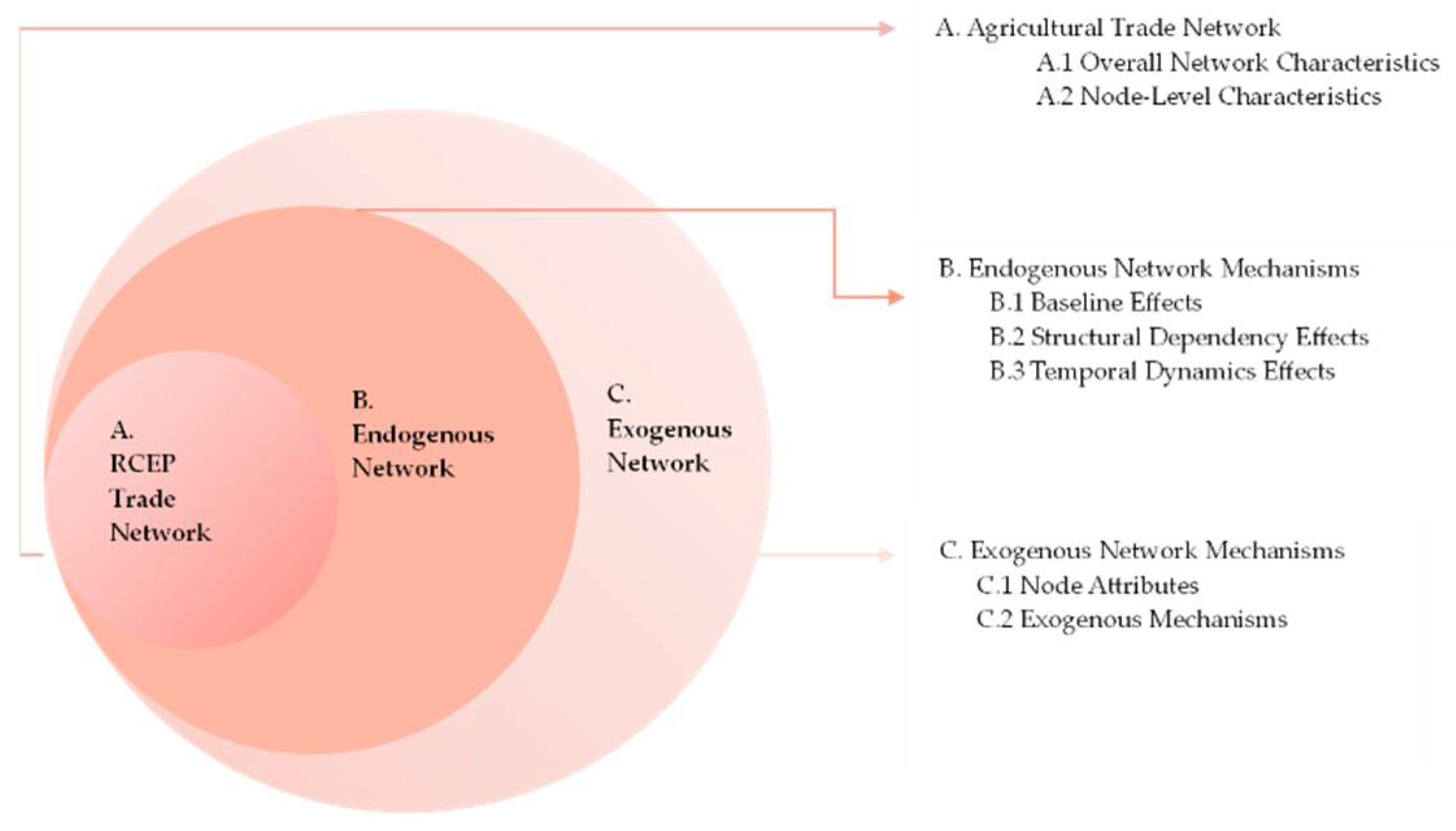
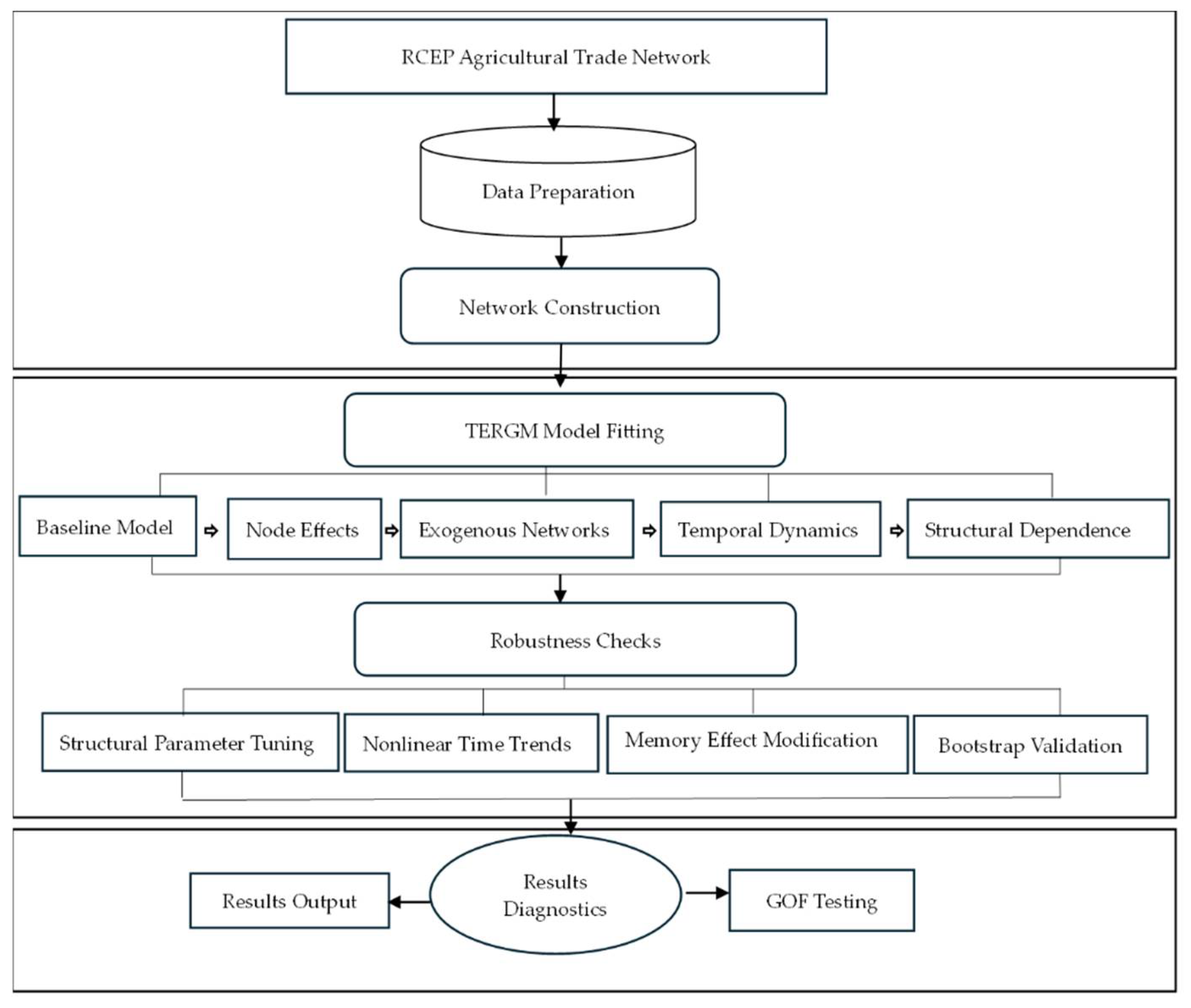
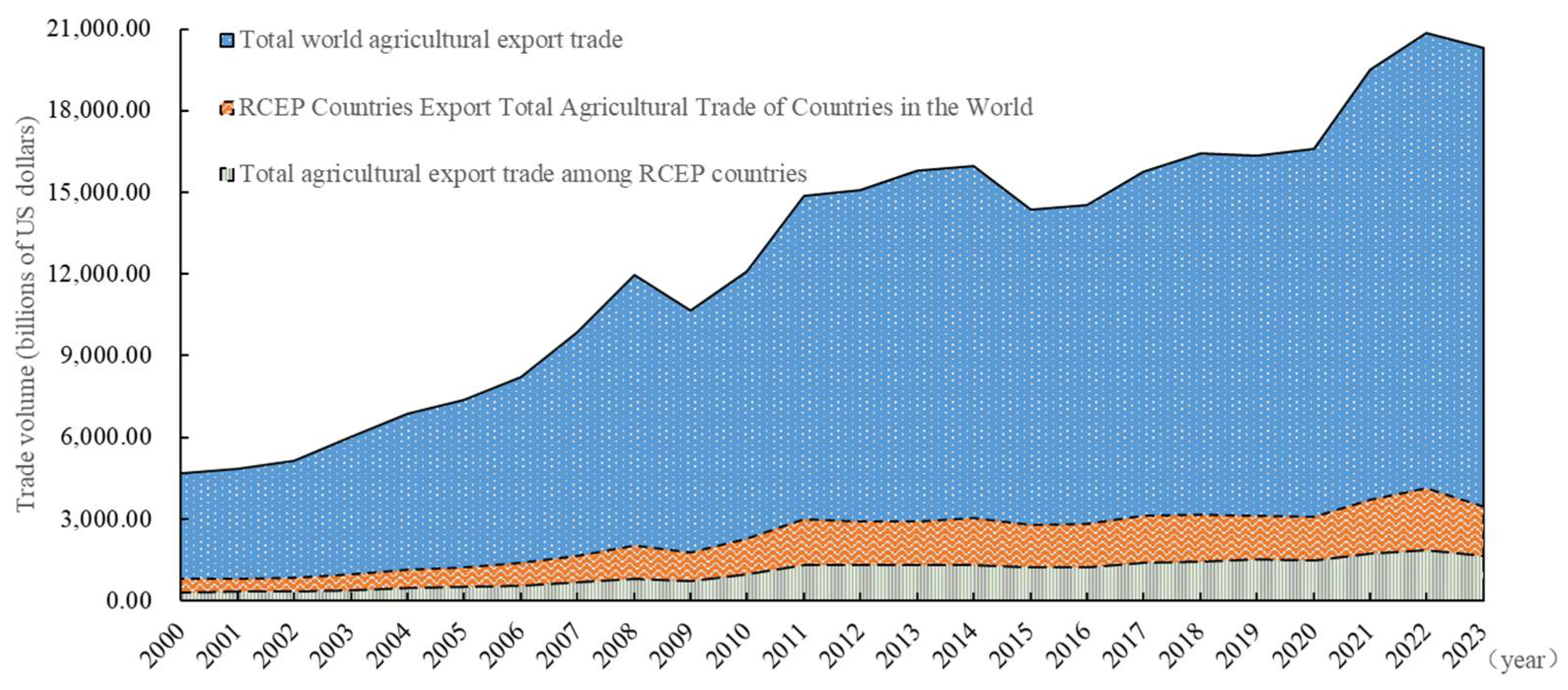
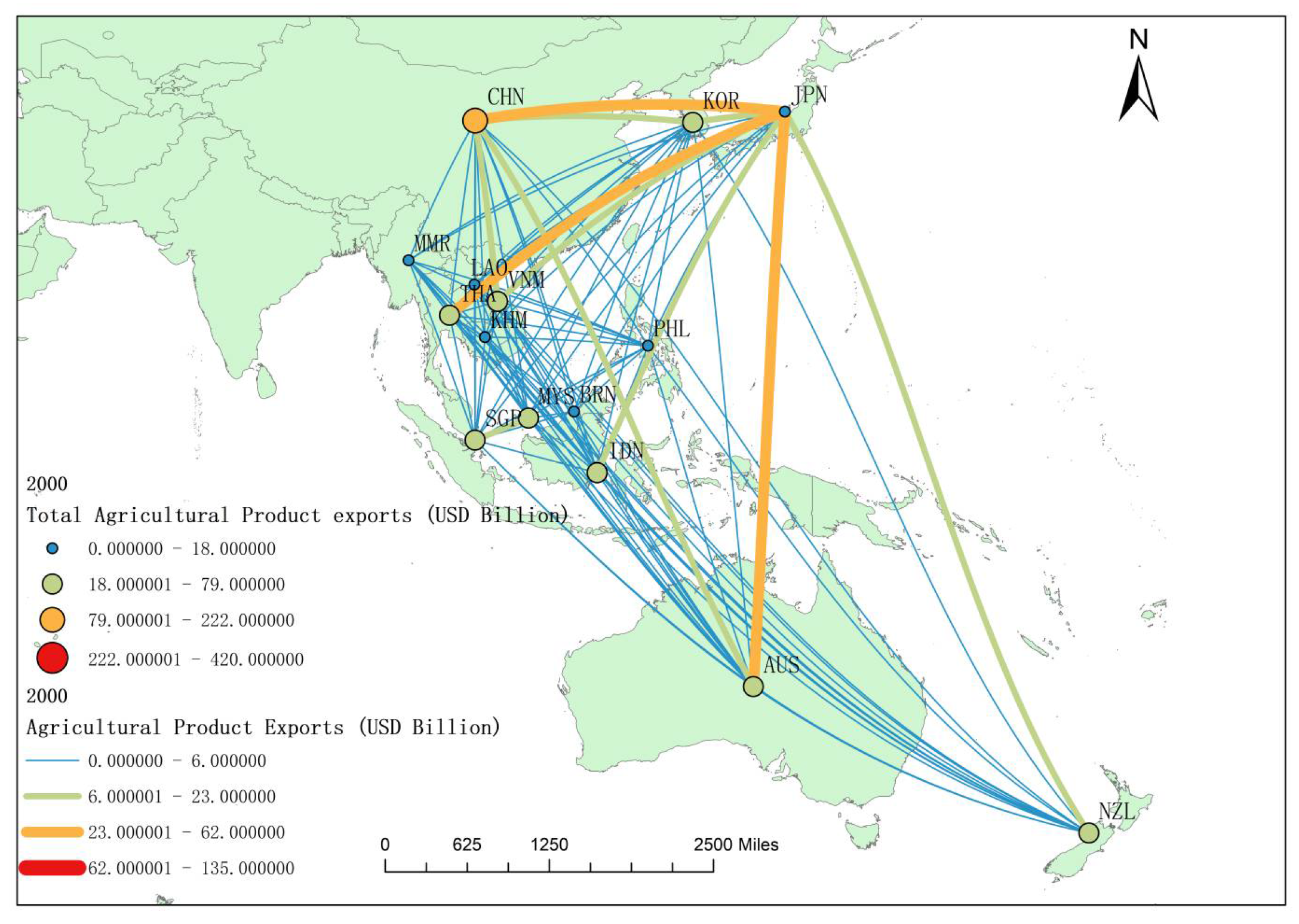

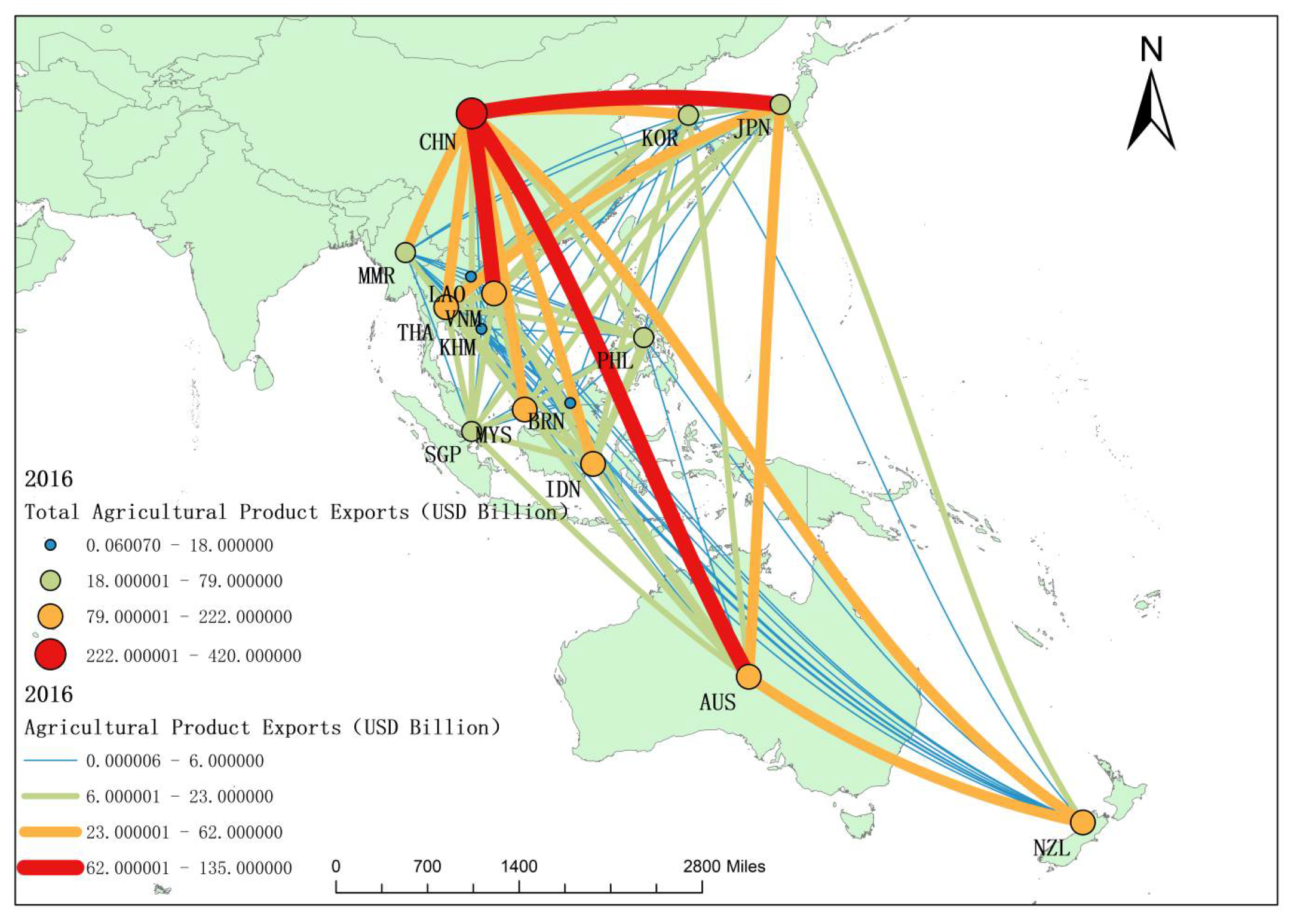
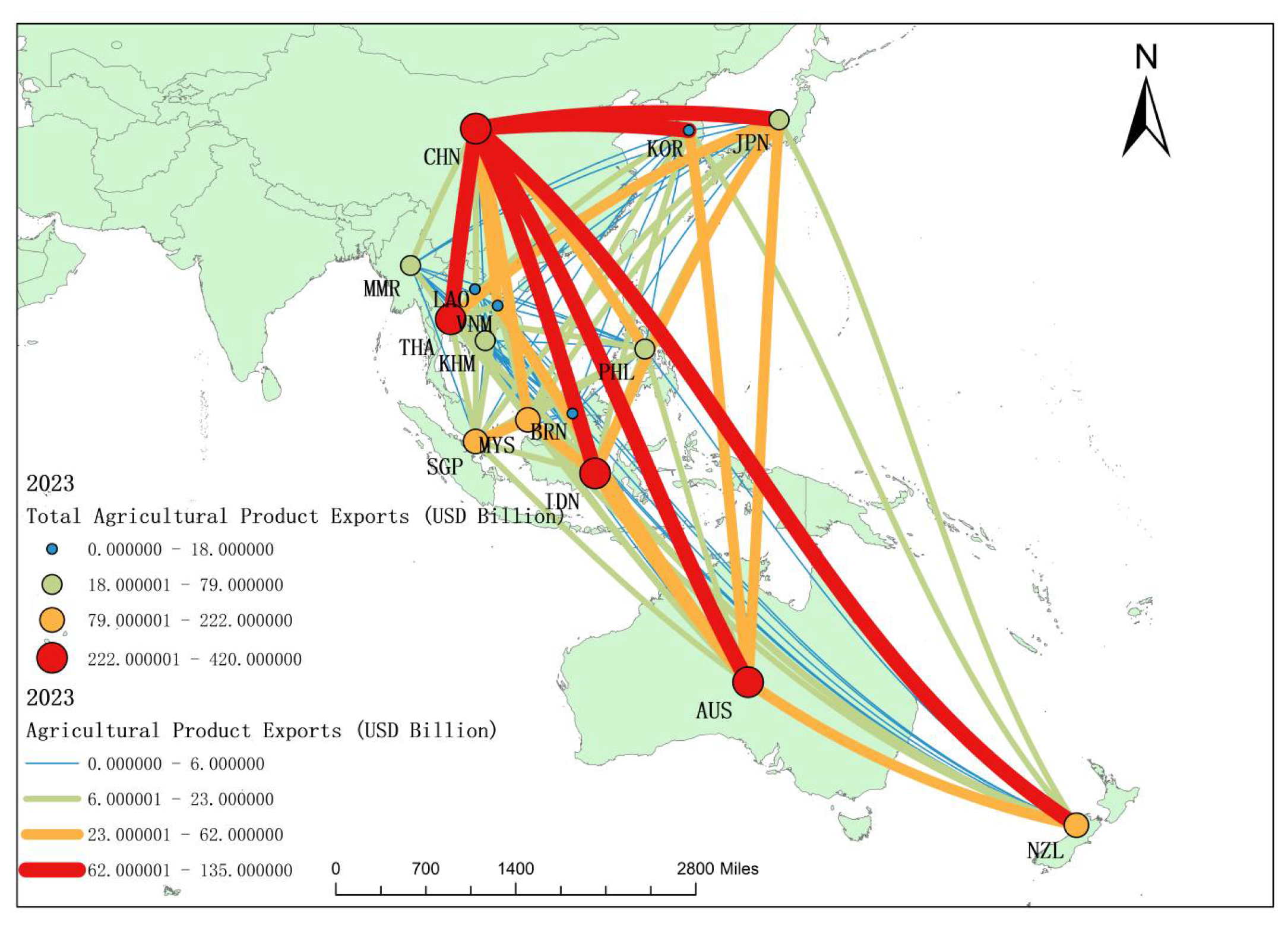


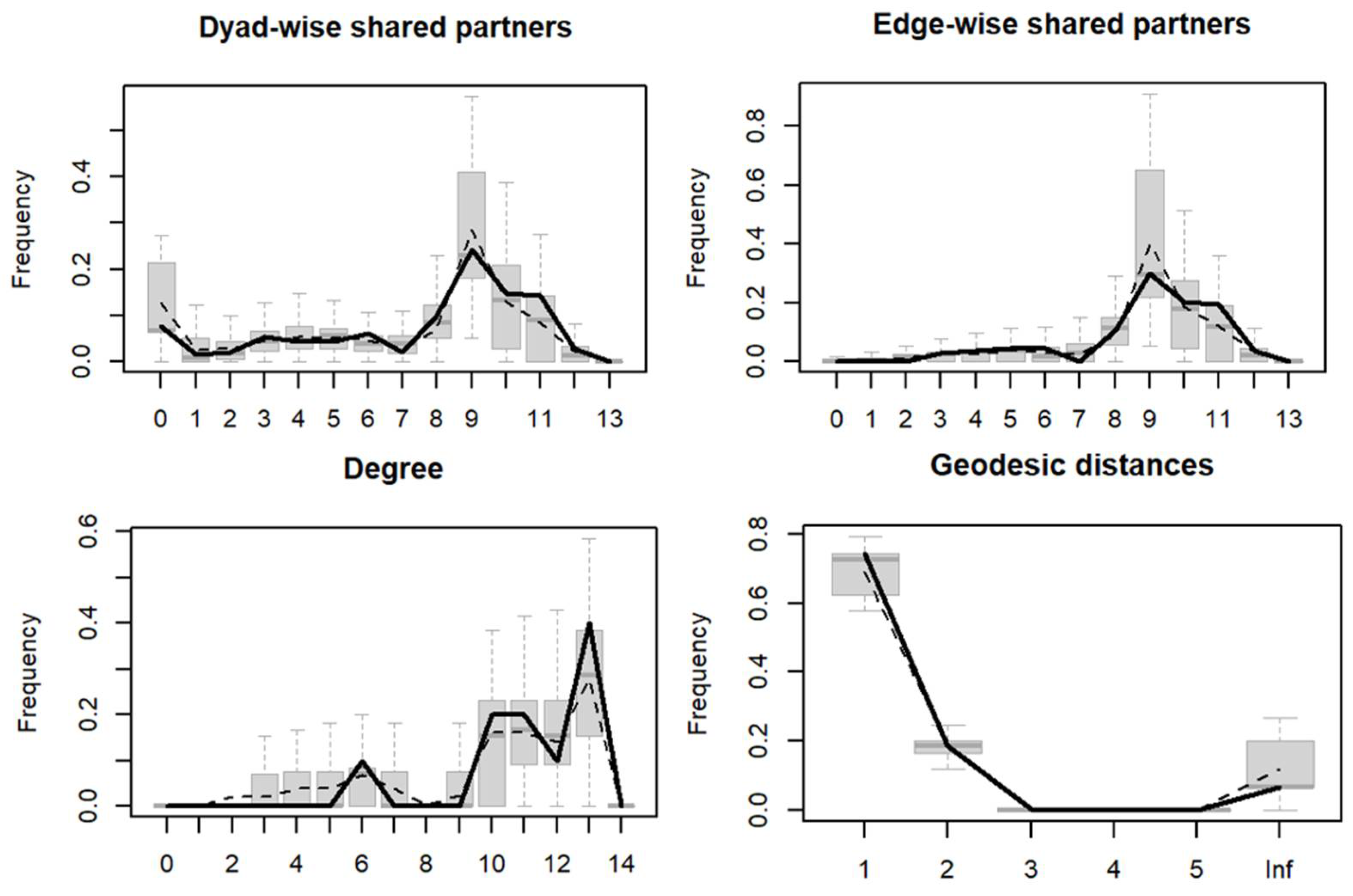
| Project | Index | Formula | Indicator Meaning |
|---|---|---|---|
| network integrity | network density | A measure of the closeness of the network. The higher the density, the wider the trade relations between member countries. | |
| number of network relationships | L | Reflect network size. | |
| network hierarchy | A measure of concentration of power or resources, with a high ranking indicating that a few countries control most trade flow. | ||
| network efficiency | The efficiency of information or resource transfer between nodes in a network. The higher the efficiency, the faster the information flow. | ||
| reciprocity | Symmetry in measuring relationships. | ||
| average path length | Average of shortest path lengths between all pairs of nodes in the network. | ||
| network diameter | The longest and shortest path length between all pairs of nodes in the network. | ||
| average clustering coefficient | Measure how closely connected nodes are to each other. | ||
| network centrality | degree centrality | Measure the direct impact of nodes. | |
| proximity centrality | Measure global reachability of nodes. | ||
| Betweenness centrality | Measure node control over the network. |
| Variable | Network Effects | Legend | Theoretical Principles | Intended Symbol | Time Attribute | |
|---|---|---|---|---|---|---|
| endogenous mechanism | Edges (edges) | base effect |  | Reference probability of random edges in a network (similar to intercept term) | − | current period (t) |
| Reciprocity (mutual) |  | Two-way trade Relationship probability (A → B and B → A) reflects network stability | + | current period (t) | ||
| Transitivity (gwdsp) | structure-dependent effect |  | Indirect routes promote direct trade (e.g., A → B → C ⇒ A → C) | − | current period (t) | |
| Proximity (gwesp) |  | Common partners lead to new relationships (triangular clustering effect) | − | current period (t) | ||
| Convergences (gwidegree) |  | Measuring capacity to attract trade flows | − | current period (t) | ||
| Expansibility (gwodegree) |  | Measuring the ability to actively expand trade | + | current period (t) | ||
| Time covariance (timecov) | time dynamic effect |  | Capture trends in trade networks over time | − | time covariate (t) | |
| Dynamic dependency (memory) |  | Historical Dependence: The Impact of the Network Structure of the Previous Period on the Current Period (yt → yt+1) | − | lag phase (t – 1 → t) | ||
| node attributes | Economic development level (GDP) | sender effect |  | Measure the positive or negative impact of node attributes of the sender (exporter) on the originating trade relationship | + | current period (t) |
| Investment freedom (iff) | − | current period (t) | ||||
| Financial freedom (ff) | + | current period (t) | ||||
| Economic development level (GDP) | receiver effect |  | Measure the attractiveness of the node attributes of the recipient (importing country) to the receiving trade relationship | + | current period (t) | |
| Investment freedom (iff) | − | current period (t) | ||||
| Financial freedom (ff) | + | current period (t) | ||||
| exogenous mechanism | Geographical proximity (geography) | exogenous network effect |  | Measuring the direct impact of external factors at the side level on trade relations | + | time-invariant |
| geographical distance (distance) | − | time-invariant | ||||
| institutional distance (regimen) | + | time-invariant | ||||
| language proximity (language) | + | time-invariant |
| Project | In 2000 | In 2005 | In 2010 | In 2015 | In 2020 | In 2023 |
|---|---|---|---|---|---|---|
| network density | 0.5762 | 0.619 | 0.7143 | 0.7429 | 0.7524 | 0.619 |
| average path length | 1.214 | 1.244 | 1.235 | 1.204 | 1.194 | 1.156 |
| network diameter | 2 | 3 | 2 | 2 | 2 | 2 |
| average clustering coefficient | 0.826 | 0.859 | 0.855 | 0.855 | 0.873 | 0.783 |
| network hierarchy | 0.598 | 0.618 | 0.604 | 0.588 | 0.611 | 0.659 |
| number of network relationships | 121 | 130 | 150 | 156 | 158 | 130 |
| network efficiency | 0.6548 | 0.7071 | 0.8238 | 0.8381 | 0.8429 | 0.6762 |
| reciprocity | 0.8099 | 0.8615 | 0.8800 | 0.8974 | 0.9114 | 0.7385 |
| Ranking | In 2000 | In 2005 | ||||||
|---|---|---|---|---|---|---|---|---|
| Degree Centrality | Proximity Centrality | Betweenness Centrality | Degree Centrality | Proximity Centrality | Betweenness Centrality | |||
| Out-Degree | In-Degree | Out-Degree | In-Degree | |||||
| 1 | CHN | JPN | JPN | CHN | CHN | JPN | JPN | CHN |
| 2 | AUS | CHN | CHN | SGP | AUS | CHN | CHN | THA |
| 3 | THA | KOR | THA | MYS | THA | KOR | THA | MYS |
| 4 | IDN | SGP | AUS | THA | MYS | MYS | AUS | AUS |
| 5 | NZL | MYS | KOR | AUS | NZL | SGP | MYS | VNM |
| Ranking | In 2010 | In 2015 | ||||||
| Degree centrality | Proximity centrality | Betweenness centrality | Degree centrality | Proximity centrality | Betweenness centrality | |||
| Out-degree | In-degree | Out-degree | In-degree | |||||
| 1 | CHN | JPN | CHN | CHN | CHN | CHN | CHN | CHN |
| 2 | THA | CHN | JPN | MYS | THA | JPN | THA | THA |
| 3 | AUS | MYS | THA | THA | AUS | VNM | JPN | MYS |
| 4 | IDN | KOR | MYS | AUS | IDN | KOR | VNM | VNM |
| 5 | MYS | IDN | IDN | JPN | VNM | MYS | AUS | AUS |
| Ranking | In 2020 | In 2023 | ||||||
| Degree centrality | Proximity centrality | Betweenness centrality | Degree centrality | Proximity centrality | Betweenness centrality | |||
| Out-degree | In-degree | Out-degree | In-degree | |||||
| 1 | CHN | CHN | CHN | CHN | CHN | CHN | CHN | CHN |
| 2 | THA | JPN | THA | THA | THA | JPN | THA | THA |
| 3 | AUS | VNM | VNM | MYS | AUS | VNM | IDN | MYS |
| 4 | IDN | KOR | JPN | VNM | IDN | KOR | AUS | JPN |
| 5 | VNM | MYS | AUS | AUS | NZL | MYS | MYS | AUS |
| Variable | Model 1 | Model 2 | Model 3 | Model 4 | Model 5 |
|---|---|---|---|---|---|
| Basic effect | |||||
| edges | −1.0046 *** (0.0644) | −26.5095 *** (1.1783) | −30.5005 *** (1.3393) | −14.2402 *** (3.0655) | −8.1273 * (3.4239) |
| mutual | 2.9624 *** (0.1097) | 2.3638 *** (0.1698) | 1.9360 *** (0.1676) | 0.8483 *** (0.2575) | 0.7435 ** (0.2845) |
| Sender effect | |||||
| GDP | 0.2046 *** (0.0323) | 0.3804 *** (0.0369) | 0.3143 *** (0.0758) | 0.4341 *** (0.0912) | |
| iff | −0.9251 *** (0.1812) | −0.8355 *** (0.1851) | −0.8244 * (0.3754) | −0.9895 * (0.4054) | |
| ff | 1.0132 *** (0.1679) | 1.1142 *** (0.1778) | 1.0488 ** (0.3356) | 1.0871 ** (0.3587) | |
| Receiver effect | |||||
| GDP | 0.8121 *** (0.0334) | 0.9393 *** (0.0362) | 0.5572 *** (0.0705) | 0.3587 *** (0.0751) | |
| iff | −1.4978 *** (0.1854) | −1.5439 *** (0.1956) | −1.0288 * (0.3993) | −0.7675 (0.4155) | |
| ff | 1.4099 *** (0.1762) | 1.7110 *** (0.1867) | 0.9348 ** (0.3515) | 0.6991 (0.3682) | |
| Exogenous network effect | |||||
| geography | 0.5828 *** (0.1513) | 0.0764 (0.3423) | 0.9945 * (0.4155) | ||
| distance | −0.7037 *** (0.0745) | −0.5567 ** (0.1798) | −0.6578 *** (0.1899) | ||
| regimen | 0.0601 (0.0253) | 0.1042 (0.0592) | 0.0927 (0.0637) | ||
| language | 1.5342 *** (0.2224) | 1.1681 * (0.5037) | 2.1969 ** (0.7201) | ||
| Time dynamic effect | |||||
| timecov | −0.1172 *** (0.0176) | −0.1497 *** (0.0187) | |||
| memory | −5.9674 *** (0.2208) | −5.5492 *** (0.2319) | |||
| Endogenous structural effect | |||||
| gwesp | −0.8124 * (0.3840) | ||||
| gwdsp | −0.3455 *** (0.0750) | ||||
| gwodegree | 10.0736 *** (8.7170) | ||||
| gwidegree | −3.3700 * (1.4486) | ||||
| Variable | Model 6 | Model 7 | Model 8 | Model 9 | Model 10 |
|---|---|---|---|---|---|
| Base effect | |||||
| edges | −7.8218 * (3.3549) | −8.4640 * (3.4384) | −8.0458 * (3.4690) | −10.8600 [−25.1338; −0.0611] | −8.4039 * (3.3223) |
| mutual | 0.7247 * (0.2894) | 0.7586 ** (0.2845) | 0.7302 * (0.2849) | 0.9239 [0.0342; 1.9346] | 0.9060 ** (0.2939) |
| Sender effect | |||||
| GDP | 0.4359 *** (0.0896) | 0.4278 *** (0.0850) | 0.4348 *** (0.0917) | 0.4764 [0.2120; 0.8207] | 0.4013 *** (0.0886) |
| iff | −1.0377 * (0.4119) | −1.0380 * (0.4285) | −1.0260 * (0.4085) | −1.1046 [−2.2994; −0.0805] | −0.2731 (0.3816) |
| ff | 1.0947 ** (0.3583) | 1.0950 ** (0.3667) | 1.0934 ** (0.3509) | 1.1742 [0.4700; 2.1489] | 0.5409 (0.3489) |
| Receiver effect | |||||
| GDP | 0.3536 *** (0.0721) | 0.3581 *** (0.0721) | 0.3600 *** (0.0753) | 0.3741 [0.2337; 0.7020] | 0.3197 *** (0.0724) |
| iff | −0.7679 (0.4103) | −0.6880 (0.4330) | −0.7938 (0.4154) | −1.4080 [−2.9214; 0.0845] | −0.0908 (0.4004) |
| ff | 0.7021 * (0.3580) | 0.6197 (0.3763) | 0.7302 * (0.3723) | 1.3778 [0.2821; 2.7264] | 0.2473 (0.3668) |
| Exogenous network effect | |||||
| geography | 0.9787 * (0.4154) | 0.9423 * (0.4124) | 0.9674 * (0.4181) | 1.1983 [0.1742; 1.9174] | 1.0610 ** (0.4066) |
| distance | −0.6550 *** (0.1927) | −0.6361 *** (0.1868) | −0.6647 *** (0.1956) | −0.5739 [−1.1100; −0.2058] | −0.6003 ** (0.1866) |
| regimen | 0.0901 (0.0656) | 0.0850 (0.0643) | 0.0927 (0.0633) | 0.0340 [−0.1569; 0.2264] | 0.0596 (0.0645) |
| language | 2.0755 ** (0.7364) | 2.3210 ** (0.7199) | 2.2013 ** (0.7360) | 2.4004 [0.4791; 5.6096] | 1.8743 ** (0.7049) |
| Time dynamic effect | |||||
| timecov | −0.1489 *** (0.0186) | −0.0059 *** (0.0007) | −0.1491 *** (0.0184) | −0.1155 [−0.1816; −0.0473] | −0.1547 *** (0.0185) |
| memory | −5.5394 *** (0.2295) | −5.7625 *** (0.2491) | −5.5367 *** (0.2298) | −6.1170 [−7.0540; −5.7833] | −5.5626 *** (0.2355) |
| Endogenous structural effect | |||||
| gwesp | −0.8959 * (0.4214) | −0.7910 * (0.3776) | −0.8059 * (0.3857) | −0.9765 [−2.2250; 0.8268] | −0.7311 (0.3784) |
| gwdsp | −0.3134 *** (0.0824) | −0.3401 *** (0.0742) | −0.3439 *** (0.0745) | −0.1367 [−0.5234; 0.0132] | −0.3368 *** (0.0747) |
| gwodegree | 7.9587 (6.6604) | 10.1242 (8.7786) | 10.2924 (8.5343) | 6.5901 [0.9078; 25.8122] | 7.7091 (8.4200) |
| gwidegree | −3.7236 * (1.5896) | −3.3651 * (1.4617) | −3.3356 * (1.4604) | −6.5794 [−9.1367; 0.8910] | −3.2773 * (1.4596) |
Disclaimer/Publisher’s Note: The statements, opinions and data contained in all publications are solely those of the individual author(s) and contributor(s) and not of MDPI and/or the editor(s). MDPI and/or the editor(s) disclaim responsibility for any injury to people or property resulting from any ideas, methods, instructions or products referred to in the content. |
© 2025 by the authors. Licensee MDPI, Basel, Switzerland. This article is an open access article distributed under the terms and conditions of the Creative Commons Attribution (CC BY) license (https://creativecommons.org/licenses/by/4.0/).
Share and Cite
Ding, S.; Wang, L.; Zhou, Q. Study on Evolution Mechanism of Agricultural Trade Network of RCEP Countries—Complex System Analysis Based on the TERGM Model. Systems 2025, 13, 593. https://doi.org/10.3390/systems13070593
Ding S, Wang L, Zhou Q. Study on Evolution Mechanism of Agricultural Trade Network of RCEP Countries—Complex System Analysis Based on the TERGM Model. Systems. 2025; 13(7):593. https://doi.org/10.3390/systems13070593
Chicago/Turabian StyleDing, Shasha, Li Wang, and Qianchen Zhou. 2025. "Study on Evolution Mechanism of Agricultural Trade Network of RCEP Countries—Complex System Analysis Based on the TERGM Model" Systems 13, no. 7: 593. https://doi.org/10.3390/systems13070593
APA StyleDing, S., Wang, L., & Zhou, Q. (2025). Study on Evolution Mechanism of Agricultural Trade Network of RCEP Countries—Complex System Analysis Based on the TERGM Model. Systems, 13(7), 593. https://doi.org/10.3390/systems13070593




